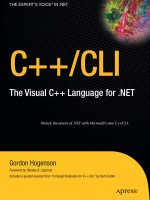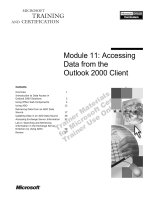Accessing the WAN
Bạn đang xem bản rút gọn của tài liệu. Xem và tải ngay bản đầy đủ của tài liệu tại đây (15.12 MB, 212 trang )
© 2006 Cisco Systems, Inc. All rights reserved. Cisco Public
1
Version 4.0
Services in a Converged
WAN
Accessing the WAN – Chapter 1
© 2006 Cisco Systems, Inc. All rights reserved. Cisco Public
2
Objectives
Describe how the Cisco Enterprise Composite
Model (ECNM) provides integrated services
over an Enterprise network.
Describe the key WAN technology concepts.
Identify the appropriate WAN technologies to
use when matching ECNM best practices with
typical enterprise requirements for WAN
communications.
© 2006 Cisco Systems, Inc. All rights reserved. Cisco Public
3
Describe How ECNM Provides Integrated
Services over an Enterprise Network
Explain the purpose and function of WANs
© 2006 Cisco Systems, Inc. All rights reserved. Cisco Public
4
Describe How ECNM Provides Integrated
Services over an Enterprise Network
Describe the stages of business growth, the
corresponding business requirements for services and
how those requirements are reflected in the
Enterprise’s changing network topology
© 2006 Cisco Systems, Inc. All rights reserved. Cisco Public
5
Describe How ECNM Provides Integrated
Services over an Enterprise Network
Describe the problems with the Hierarchical Design
Model that Cisco's Enterprise Composite Model has
been designed to address
© 2006 Cisco Systems, Inc. All rights reserved. Cisco Public
6
Describe How ECNM Provides Integrated
Services over an Enterprise Network
Explain the purpose of Cisco Enterprise Architectures
© 2006 Cisco Systems, Inc. All rights reserved. Cisco Public
7
Describe the Key WAN Technology
Concepts
Describe WAN functions in terms of the OSI Reference
Model
© 2006 Cisco Systems, Inc. All rights reserved. Cisco Public
8
Describe the Key WAN Technology
Concepts
Describe the key WAN physical layer concepts for
network and Internet communications
© 2006 Cisco Systems, Inc. All rights reserved. Cisco Public
9
Describe the Key WAN Technology
Concepts
Describe the key WAN data link layer protocols used in
today’s Enterprise WAN networks
© 2006 Cisco Systems, Inc. All rights reserved. Cisco Public
10
Describe the Key WAN Technology
Concepts
Describe the switching technologies used for WANs in
an Enterprise setting
© 2006 Cisco Systems, Inc. All rights reserved. Cisco Public
11
Select the Appropriate WAN Technology to meet
ECNM Requirements
List the various options for connecting subscribers to
the WAN
© 2006 Cisco Systems, Inc. All rights reserved. Cisco Public
12
Select the Appropriate WAN Technology to meet
ECNM Requirements
Describe how Enterprises use leased line services to
provide a WAN connection
© 2006 Cisco Systems, Inc. All rights reserved. Cisco Public
13
Select the Appropriate WAN Technology to meet
ECNM Requirements
Describe the circuit switching options available to
provide a WAN connection
© 2006 Cisco Systems, Inc. All rights reserved. Cisco Public
14
Select the Appropriate WAN Technology to meet
ECNM Requirements
Describe the packet switching options available to
provide a WAN connection
© 2006 Cisco Systems, Inc. All rights reserved. Cisco Public
15
Select the Appropriate WAN Technology to meet
ECNM Requirements
List factors to consider when selecting a WAN
connection
© 2006 Cisco Systems, Inc. All rights reserved. Cisco Public
16
Summary
A WAN is defined as
A data communications network that operates beyond the
geographic scope of a LAN
WAN primarily operate on layer 1 & 2 of the OSI model
WAN technologies include
–Leased line
–ISDN
–Frame relay
–X.25
–ATM
© 2006 Cisco Systems, Inc. All rights reserved. Cisco Public
17
Summary
Cisco Enterprise Architecture
–This is an expansion of the hierarchical model that further
divides the enterprise network into
•Physical areas
•Logical areas
•Functional areas
Selecting the appropriate WAN technology requires
considering some of the following:
–WAN’s purpose
–Geographic scope of WAN
–Traffic requirements
–If WAN uses a public or private infrastructure
© 2006 Cisco Systems, Inc. All rights reserved. Cisco Public
18
© 2006 Cisco Systems, Inc. All rights reserved. Cisco Public
1
Version 4.0
Point-to-Point Protocol
(PPP)
Accessing the WAN – Chapter 2
© 2006 Cisco Systems, Inc. All rights reserved. Cisco Public
2
Objectives
Describe the fundamental concepts of point-to-point serial
communication including TDM, demarcation point, DTE-DCE
functions, HDLC encapsulation, and serial interface
troubleshooting.
Describe PPP concepts including PPP layered architecture, PPP
frame structure, PPP session establishment, multiprotocol
encapsulation support, link control protocol (LCP), network
control protocol (NCP), and Internet Protocol Control Protocol
(IPCP).
Configure PPP on a serial interface including enabling PPP
encapsulation, verifying the PPP connection and troubleshooting
encapsulation problems.
Configure PPP authentication including explaining PAP and
CHAP authentication protocols, configuring PPP authentication
using PAP and CHAP, and troubleshooting PPP authentication
problems.
© 2006 Cisco Systems, Inc. All rights reserved. Cisco Public
3
Describe the Fundamental Concepts of
Point-to-Point Serial Communication
Describe the concept of serial communication as the
basis of WAN technologies
© 2006 Cisco Systems, Inc. All rights reserved. Cisco Public
4
Describe the Fundamental Concepts of
Point-to-Point Serial Communication
Explain how two or more data streams are transported
across a single physical connection using TDM
© 2006 Cisco Systems, Inc. All rights reserved. Cisco Public
5
Describe the Fundamental Concepts of
Point-to-Point Serial Communication
Define the location of the demarcation point relative to
customer and service provider networks
© 2006 Cisco Systems, Inc. All rights reserved. Cisco Public
6
Describe the Fundamental Concepts of
Point-to-Point Serial Communication
Explain the terms DTE and DCE with relative to the
location of devices in a network
© 2006 Cisco Systems, Inc. All rights reserved. Cisco Public
7
Describe the Fundamental Concepts of
Point-to-Point Serial Communication
Describe how high-level data link control (HDLC) uses
one of three frame types to encapsulate data









